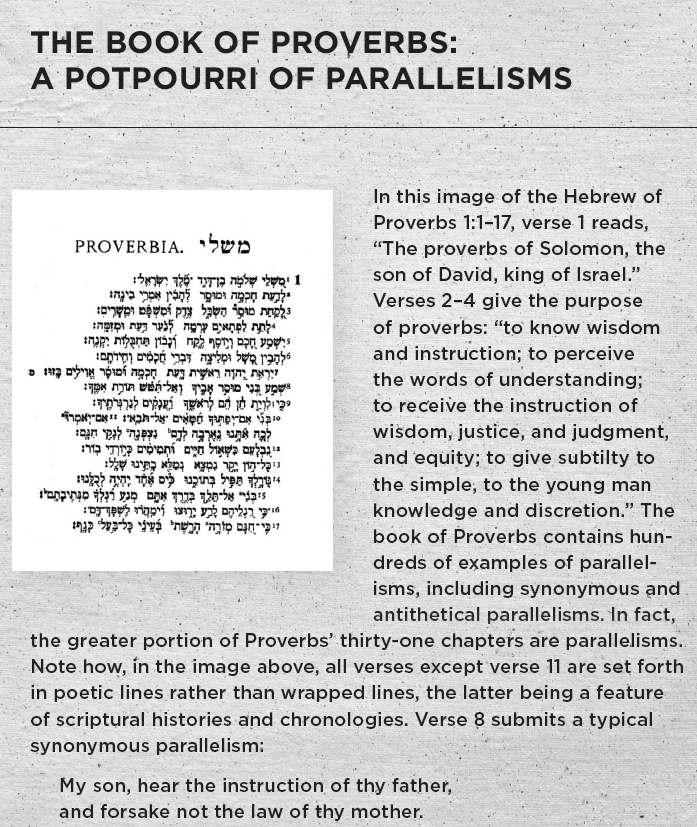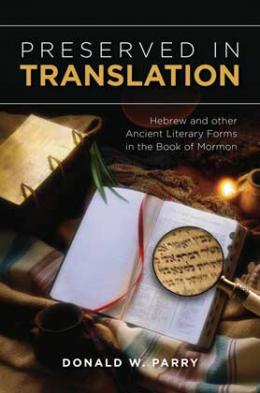Synonymous Parallelism
Donald W. Perry, “Synonymous Parallelism,” in Preserved in Translation: Hebrew and Other Ancient Literary Forms in the Book of Mormon (Provo, UT: Religious Studies Center, Brigham Young University; Salt Lake City: Deseret Book), 13‒19.
"hear, O heavens, and give ear, O earth" (Isaiah 1:2)
Poetic parallelism is the most basic form of poetry in the Old Testament.[1] As Watson has written, “Parallelism is universally recognized as the characteristic feature of biblical Hebrew poetry.”[2] Hebrew scholar James L. Kugel points out that poetic parallelism is “the basic feature of biblical songs—and, for that matter, of most of the sayings, proverbs, laws, laments, blessings, curses, prayers, and speeches found in the Bible.”[3] Examples of parallelism number in the thousands in poetic works, with more than a thousand in Isaiah alone.[4] In some cases, such as in Proverbs and Isaiah, entire chapters are filled exclusively with two-lined poetic parallelisms. (Many other examples can be found in Psalms, Joel, and elsewhere.)
A parallelism generally consists of two lines, with each line having features or expressions that parallel or correspond with the other. For example, in the parallelism “Hear O heavens and give ear O earth” (Isaiah 1:2), hear parallels give ear and heavens parallels earth. The prophet-psalmist thus sets forth his ideas in the first line, then restates, reinforces, or reconfigures them in the next line. This reconfiguration may serve to emphasize, broaden, or add further light to the first clause. In a parallelism, both lines are equally important. The second line, writes Kugel, is “not expected to be (nor regarded as) mere restatement” of the first half, but is meant to “add to it, often particularizing, defining, or expanding the meaning, and yet also to harken back” to it.[5]

Hebrew poetic parallelism was not a mere literary trick—it had a higher purpose. Prophets and poets created parallelisms to teach significant doctrines about the Lord; about his character, divine attributes, and qualities; about his workings with individuals, families, peoples, and nations; and more. Parallelisms can come in a variety of configurations (in this book I deal with three primary types—synonymous, antithetical, and coordinating).
The Old Testament features thousands of synonymous parallelisms in Psalms, Proverbs, Isaiah, and other books. Following are four brief examples.
Adah and Zillah, Hear my voice;
Ye wives of Lamech, hearken unto my speech. (Genesis 4:23)
Three separate elements in the second line correspond with elements in the first line: Adah and Zillah are the names of the wives of Lamech, the word hear is the equivalent of hearken, and my voice corresponds with my speech.
Look unto Abraham your father,
and unto Sarah that bare you. (Isaiah 52:2)
This parallelism pairs male and female twice: Abraham with Sarah and, by extension, father with mother (she “that bare you”).
Awake, awake; put on thy strength, O Zion;
put on thy beautiful garments, O Jerusalem, the holy city. (Isaiah 52:1)
This parallelism pairs the commands put on thy strength with put on thy beautiful garments, as well as the holy cities Zion with Jerusalem. Note also that in this passage the prophet Isaiah utilizes parallel structure to associate garments in the second line with strength in the first line, conveying the religious idea that God’s people who clothe themselves with “beautiful garments” clothe themselves with strength.[6]
we should have been as Sodom,
and we should have been like unto Gomorrah. (Isaiah 1:9)
This brief parallelism pairs two similes, introduced with as and like. Each line begins with the same words, we should have been, and end with the two corresponding sister cities, Sodom and Gomorrah. These cities parallel each other perfectly: both were so wicked that they were destroyed by the power of God.
Having emerged from the world of the Old Testament, the Book of Mormon likewise contains a number of synonymous parallelisms. This literary form is not as plentiful in the Book of Mormon because the Old Testament contains several books that are wholly dedicated to poetic structures (Psalms, Proverbs, Ecclesiastes, and most of Isaiah), while the Book of Mormon consists primarily of historical narrative (roughly corresponding to the Old Testament books of Genesis, Judges, Samuel, Kings, Chronicles, and so forth).
pray unto him continually by day,
and give thanks unto his holy name by night. (2 Nephi 9:52)
As can readily be seen, the command to pray pairs with give thanks, unto him parallels unto his holy name, and by day corresponds with by night.
for their works were works of darkness,
and their doings were doings of abominations. (2 Nephi 25:2)
Here their works, works, and darkness pair with their doings, doings, and abominations.
Wo unto him that spurneth at the doings of the Lord;
yea, wo unto him that shall deny the Christ and his works! (3 Nephi 29:5)
In this example, Wo unto him occurs on each line, spurneth is paired with shall deny, doings is linked to works, and Lord corresponds with Christ.
Yea, my heart sorroweth because of my flesh;
my soul grieveth because of mine iniquities. (2 Nephi 4:17)
In this parallelism, heart and soul correspond, sorroweth and grieveth are synonyms, and my flesh parallels mine iniquities.
Behold, my soul is rent with anguish because of you,
and my heart is pained. (1 Nephi 17:47)
This example pairs my soul with my heart, and rent with anguish corresponds with is pained.
Notes
[1] See Bullinger, Figures of Speech Used in the Bible, 349–50. For an exploration of parallelisms in the Bible and the Book of Mormon, together with a definition and multiple examples, see Parry, Poetic Parallelisms in the Book of Mormon, xii–xxxiv. For a list of synonymous parallelisms in the Book of Mormon, see the index of poetic forms therein on pp. 566–67 (under the entries “extended synonymous” and “simple synonymous”).
[2] Watson, Classical Hebrew Poetry, 114. For a lengthy study of parallelism, including definitions and various categories of parallelisms, see pp. 114–59. For additional biblical examples of various types of parallelisms, examine the comprehensive study of Bullinger, Figures of Speech Used in the Bible, 349–62. See also Berlin, Dynamics of Biblical Parallelism, 3. One of the earliest scholars to examine the role of parallelisms in the Bible was Robert Lowth, who authored a two-volume work on the topic, Lectures on the Sacred Poetry of the Hebrews. Concerning the history of the study of biblical parallelism, see Kugel, Idea of Biblical Poetry, 96–170; and Broadribb, “Historical Review of Studies of Hebrew Poetry.”
[3] Kugel, Idea of Biblical Poetry, 1.
[4] For the entire book of Isaiah laid out in parallelistic form, see Parry, Harmonizing Isaiah.
[5] Kugel, Idea of Biblical Poetry, 8.
[6] The idea of “beautiful garments” being associated with strength is further interpreted in Doctrine and Covenants 82:14 and 113:8.
